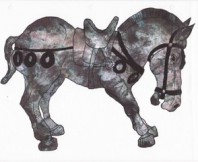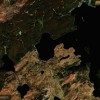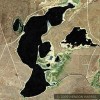
Did The Chinese Discover America?
I believe I have located and identified Pre-Columbian Land Art in North America which bears evidence of an ancient Chinese Dynasty. This is significant because if proven true it places a highly advanced civilization in North America well before the arrival of Europeans. This may well be the early civilization that built the cities and created the mines that the Spanish explorers introduced to the western world as El Dorado. In addition to the art I think I have located some of the mines as well.
“One measure of a civilization is the monumentality of its buildings (ART), an indication of wealth exceeding a society’s survival needs.”
The Rise & Fall of Civilazations-Part 2
Miller, Joubert & Butler
Over the upcoming weeks it is my intention to introduce you to this fascinating art form and to explain how it ties into world history. I must warn you that this topic will be highly controversial because it contradicts much of what we currently believe about North American history prior to the arrival of Columbus as well as the level of technology achieved by these ancient people, the forefathers of Native Americans.

Please be patient with me as we go through this process together. I assure you that the theory I am sharing is plausible even if not completely correct in every detail. All my observations need to be checked out for accuracy but in the end I believe you will agree with my theory which is that ANCIENT CHINESE PEOPLE NOT ONLY MIGRATED TO NORTH AMERICA BUT ESTABLISHED LARGE POPULATION CENTERS AND ART WHICH CAN BE SEEN TO THIS DAY VIA SATELLITE PHOTOGRAPHY.
Let’s start with the visible ancient land art. I have posted two images of what can be seen now. This is a fraction of the actual photographs that I currently have and will share with you over time. I hope you will join me in viewing this art as I reveal the locations or as you find them on your own.

I’ll begin with the Chinese Tang Dynasty Style Horse that I am calling The Harris Horse , after my father, Dr. Hendon M. Harris. My father put “his horse” into the race in 1972 and although he died in 1981 others continue his work and will in my opinion “bring his horse over the finish line” of the common acceptance of massive Asian migrations over thousands of years and Asian population centers in North America. Our father wrote the book “Asiactic Fathers of America”.
The Harris Horse is primarily in Southern Wyoming but its lower legs and hooves are in Northern Colorado. Yes it is huge. The horse is at least 120 miles from head to tail. From hoof to hoof the distance is approximately 70 miles. It has a clearly identifiable Asian style saddle with a visible stirrup, cinch belt and a “black water” lake in the shape of an Asian lady for its eye. The clearly crafted shape of the horse and its short tail (Tang Dynasty Style) Asian saddle and Asian eye positively identify it as an Asian creation. Why is the largest Tang Dynasty style horse image in Wyoming?
For the answer to that question you must go to the Fourth Volume of the Shan Hai Jing (SHJ). The Shan Hai Jing may be the oldest geography book in the world. It was written in China in approximately 2200 B.C. That is 4200 years ago. The Shan Hai Jing details expeditions commissioned by the Chinese emperor at that time. He ordered that the four corners of the world be explored and surveyed. Because of the scope of the task modern historians have assumed him to mean the four corners of China. However recent research shows that he actually sent them to survey the four corners of the entire world and they did exactly that. These images help substantiate those worldwide surveys.

About fifty years ago Henriette Mertz working on research provided by Edward Vining in his book “An Inglorious Columbus” located what she believed to be the location of an expedition described in Volume 4 of the SHJ. The descriptions of each location were too precise to be anywhere else in the world but a line from Casper, Wyoming running all the way down to the Rio Grande. Looking at this expedition path via satellite imagery one can see that it follows almost exactly the eastern slopes of the Rocky Mountains.
The descriptions of the journey’s mid points match up to the Chinese accounts. The eleventh site description was of a location called “Bald Mountain” by the early Chinese explorers. At this location the Chinese expedition found small pig like animals with pearls protruding from their mouths. A description was given of the direction the water ways flowed. Today “Bald Mountain” is known as “Baldy Peak” because it looks like a bald head. It is a stone outcropping on the top of Mt. Livermore, Texas. The small pigs are the native javelinas with tusks protruding from their mouths who thrive in abundance even now in that area. The streams still flow today the way they were described. Guadalupe Peak one hundred miles to the north was the 10th location described. The Chinese journal referred to it as “Lone Mountain”. Anyone who has seen Guadalupe Peak/El Capitan from the south looking north knows exactly why it was called “Lone Mountain”. Guadalupe Peak/El Capitan rises out of the Texas plain like the bow of a huge ship. Although it is the front end of a large mountain range which extends for miles it appears ALONE.  It stands majestically high over the surrounding area.
A large area of sand is described in the SHJ in Colorado exactly where the Great Sand Dunes National Park is located. How could the ancient Chinese of 2200 BC know that? The descriptions go on and on. Read them for yourself in Henriette Mertz’s book Pale Ink or the abridgment of my father’s book (The Asiatic Fathers of America Pages 114-116).
Now we come to the most challenging portion of this theory because it asks you, the reader, to believe that the ancients who crafted this art were capable of flight. That is unless one can believe that these images could or would be created without ever being seen.
What is generally not known and not taught in the western world is that Asians have been capable of flight for hundreds if not thousands of years. Asian flight via kites and hang gliders is widely accepted. Marco Polo gave an account of seeing this himself. Man-Flying Kites. Ancient Asian wind powered flight is an established fact. It was done primarily by Taoist priests known as “feathered guests”. We still have a challenge though because The Harris Horse can only be seen from beyond the range of “wind powered” flight. Could the ancients have achieved powered flight? That’s the question.
Ancient literature from several parts of the world but especially from India gives incredibly accurate descriptions of powered flight. Several scholars of flight and of these areas have researched this topic and their research continues. What has been lacking is the proof. Something like the remains of ancient aircraft, an ancient airport or anything that would point to ancient powered flight would help prove up these written documents. Will these enormous art pieces be that proof?
You can read of the references to ancient powered flight by googling references to “Vimana”. Vimana is the name given to aircraft found in ancient manuscripts from India. If these manuscripts are correct the ancient aircraft were superior to what we have today. Don’t just take my word for it. Read it for yourself. There are reports that Chinese scientists have recently or are now researching these documents for ways to improve their own aircraft and /or spacecraft technology.
In closing this introduction I humbly acknowledge I am not an artist nor am I a scientist. I am a businessman with an undergraduate degree in history. However, I believe I have found art that may change historical thought by providing possible evidence to show that the Chinese did indeed Discover America prior to the visitations of the Western European explorers.
Hendon Harris

















